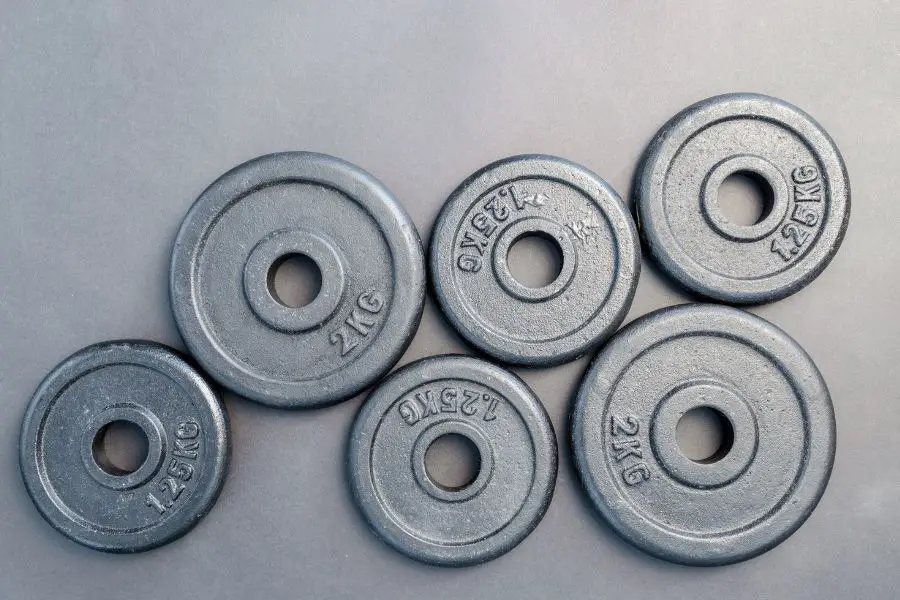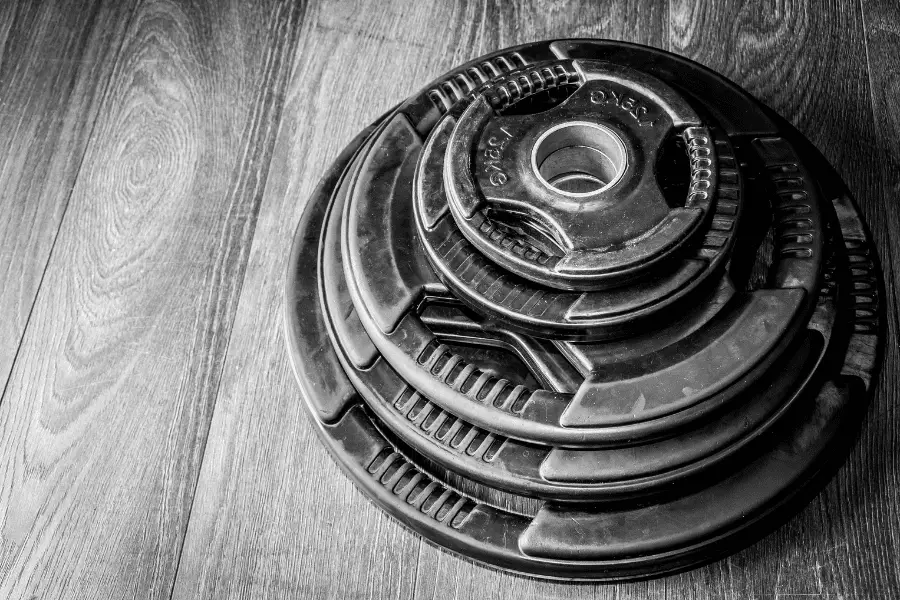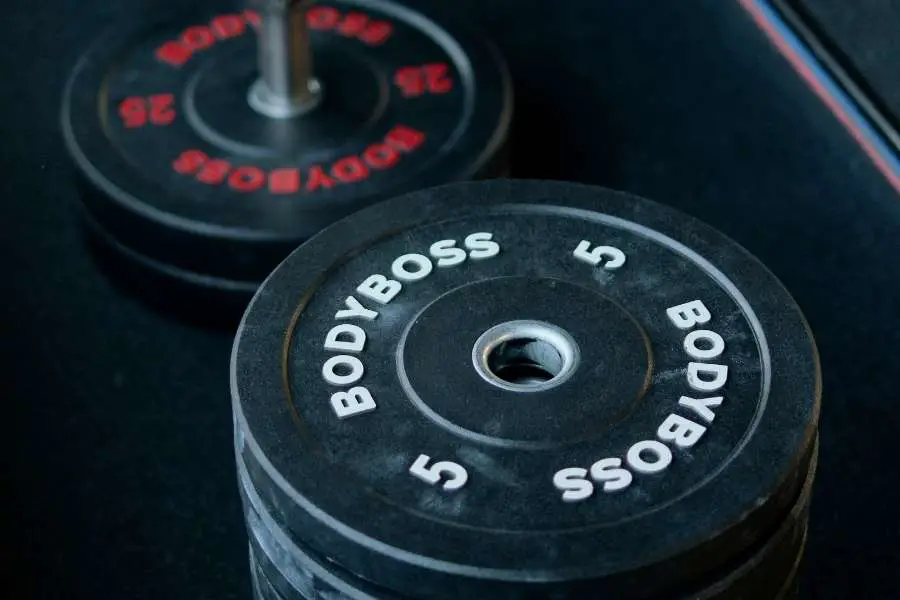Weight plates are just plates and fit on all barbells and equipment, right? Nope, sorry. When you’re building a home gym, it’s important to match up your weight plates and barbells/other equipment. Not doing so might lead to some equipment being completely unusable.
Weight plates do not fit on all bars and equipment. There are weight plates with 1″ (25mm) and 2″ (50mm) diameter holes. These dimensions have to match up with the dimensions of the barbell sleeve or equipment pegs to fit properly. A mismatch either doesn’t fit or has a fit that’s too loose to be safe.
Let’s dive into the specifics of how weight plates fit on barbells and how you can choose the right version for your home gym.
Contents
Do All Weight Plates Fit On All Barbells and Equipment?
Not all weight plates fit on all barbells and equipment. There are a few key measurements that impact if a weight plate fits on your barbell or equipment.
If those two match measurements match, those bar and plates fit together. If not, you’re out of luck and should get a new bar or plates.
| Standard Barbell/Pegs (1”/25mm Sleeve) | Olympic Barbell/Pegs (2”/50mm Sleeves) | |
| Standard Plates (1”/25mm hole) | Fits | Doesn’t Fit |
| Olympic Plates (2”/50mm Sleeves) | Only Fits With Adapter | Fits |
Plate Hole Size
Do all weight plates have the same size hole?
Weight plates come with two different diameter inside holes; 1″ and 2″. Weight plates with a 1″ inside hole are often known as ‘standard plates’ while ones with a 2″ diameter hole are known as ‘Olympic’ plates.
While the diameter is often indicated in inches, they are actually 25 and 50 mm respectively. Also, while plates are advertised as having a 50mm/2″ hole, they are often slightly bigger than that. That’s because they have to fit on the barbell. The barbell sleeves are usually exactly 50mm so the hole in the plates has to be slightly larger (usually around 50.5mm) to fit.
Barbell and Equipment Sleeve Size
Do all barbell sleeves and equipment pegs have the same diameter?
Barbell sleeves and equipment pegs come in two different sizes; 25mm and 50mm (1″ and 2″). It should be no surprise that these dimensions match up with the different hole sizes in the weight plates.
The dimensions should match otherwise it won’t work. A 1″ plate can in no way fit on a 2″ sleeve. 2″ plates could fit on 1″ pegs but very loosely. I can’t recommend this because They can fall off too easily.
Barbells with 1″ sleeves are often known as ‘standard’ bars while bars with 2″ sleeves are known as ‘Olympic’ bars. Except looking somewhat similar, that doesn’t means you’re getting necessarily the same equipment as used in the Olympics though. It’s purely marketing speak for plates with 2″ diameter holes and bars with spinning 2″ sleeves.

2″ Adapter
If you’ve got 1″ sleeves on your bar but 2″ plates, there is a hack to make it work. There are adapters you can slide over the original 1″ part and increase the diameter to 2″. That way you can safely put 2″ weight plates on a 1″ Bar.
However, these adapters don’t spin like a real 2″ Olympic bar. That means you still have to deal with the drawbacks of 1″ plates.
Types Of Weight Plates
Standard Weight Plates

The defining characteristic of ‘standard’ plates is the 1″/25mm hole in the middle. They are often bare cast iron but they can have a rubber casing and grip holes as well.
Standard weight plates are for use with standard 1″ barbells and lower-end or very old plate-loaded machines.
Olympic Plates

These are not necessarily the plates they use at the Olympics although the name is confusing. When buying home gym equipment, the ‘Olympic’ label means; 2″/50mm.
That means these plates are suitable for use with Olympic barbells and high-quality strength machines.
They come in a wide variety of styles. Some are solid while others have grip holes. Many are rubber-encased but many aren’t. All those characteristics don’t make a plate ‘Olympic’, it’s just the 2″ hole that matters.
Find the best 2″ weight plates for your garage gym in this article.
Bumper Plates

Bumper plates can be seen as a subset of Olympic plates. I included them here because people that aren’t into gym equipment will think of these plates when they hear “Olympic weight plates”. That’s because this is the type of plate they use for most weightlifting competitions.
They are for use with Olympic barbells with 2″ sleeves. Bumper plates aren’t good for use on plate loaded machines.
Bumper plates are completely made out of rubber and only have a metal insert around the 2″ hole. The rubber construction means that they can be dropped from overhead, like in Olympic-style weightlifting, without getting damaged.
Because rubber is obviously lighter than steel, bumper plates are much thicker than standard and Olympic plates.
Choosing The Right Weight Plates For Your Bar/Equipment
Should you Choose 1″ or 2″ Gym Equipment?
For people that don’t have any equipment yet, always choose 2″ bars and plates. They have some big benefits;
The only reason to choose 1″ equipment is that it’s slightly cheaper. But as said, you often get lower quality stuff so in the end you get what you pay for.
For people that already have a barbell or plates that are 1″, it makes sense to match your other equipment to this. However, you should consider selling your old stuff and upgrading to 2″ if you’re serious about having good gym equipment.
If you have plate-loaded equipment already, get plates with the same diameter as the pegs on the machines. Machines are way more expensive than a set of plates so it wouldn’t make sense to buy new machines just to change plate type.
Grip vs. Bumper Plates
For most people, 2″ rubberized grip plates are the best weight plates for a home gym.
Bumper plates are only really useful if you’re dropping weights from overhead very regularly. Normal rubberized plates won’t survive that.
However, if you don’t drop weights from that high, rubberized grip plates will actually last longer than bumper plates. An added benefit is that they’re smaller and have grip holes so they’re easier to handle.
Plate-loaded machines are made to be used with non-bumper plates. Bumper plates are too thick and the pegs on machines are often quite short. Using bumper plates might fit on a machine but it means you can load very little resistance.
High-Quality Barbells And Tolerances
While it’s generally true that 1” plates fit 1” barbells and the same goes for 2”, there’s a catch to be aware of, especially if you’re working with very high-quality bars or plates.
Some barbell and weight plate brands stand out for their precision – the ones you often see in official competitions like IVANKO, Eleiko, and York. These top-tier brands set the standard with tight tolerances, ensuring a snug fit. They have to be very accurate, otherwise, their equipment wouldn’t be used in competitions.
Tolerances Matter
High-quality barbells and plates are machined to very small tolerances. Good brands will have equipment with a sleeve diameter of 49.5 to 50 millimeters and weight plate hole sizes between 50.2 and 50.8 millimeters. The tiny differences reveal how meticulously they’re designed to match.
When you pair high-quality plates and barbells, there’s a perfect union, no fuss. You’ll get a perfect, tight fit.
The Compatibility Conundrum
However, here’s where things get interesting. Mixing budget-friendly gear (with wider tolerances) and high-quality pieces cause compatibility concerns. While they should theoretically be the same size, the truth is, lower quality barbells and plates are often produced with wider tolerances. This can result in an unexpected misfit.
Size Mismatch Examples
For instance, a lower-quality barbell might have a sleeve diameter of 49 to 50.5 millimeters. Pair that with weight plates boasting hole measurements of 50.2 to 50.8 millimeters. Suddenly you’ll have a fit that’s a bit too tight or too loose.
Too loose is often fine since we’re talking about half a millimeter here but, too tight and it won’t fit. Let me get this clear: it’s very rare that something doesn’t fit but it can happen.
Finding Harmony
If both your bar and plates have generous tolerances, you’re usually in the clear. Manufacturers typically adjust the plate hole size slightly to accommodate bigger tolerances, ensuring a match even if they’re not a perfect fit.
Cheaper plates and bars work perfectly fine together. Expensive bars and cheap plates also work because cheaper plates tend to have slightly larger holes. Cheap bars and Expensive plates might cause issues.
I don’t know why you would buy expensive plates and a cheap bar but hey, it could happen. Most people are better off getting a good barbell and cheap plates if budget is a concern.
FAQ
Can I use Olympic plates on a regular bar? Yes, it is possible to use weight plates with a 2” hole on 1” barbell sleeves. It might not be as secure and stable as properly fitting plates, however. It’s best to use collars or clips since the plates could slide off easier. Alternatively, you can use an adapter that will turn your 1” sleeve into a 2” sleeve.
What is the difference between standard and Olympic weight plates? The biggest difference between regular plates and Olympic plates is the center hole diameter. Regular plates have a 1” diameter hole while Olympic plates have 2” holes. Olympic-style plates are also available in more styles like bumper plates.
